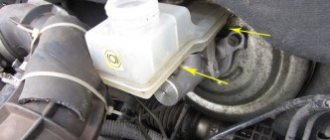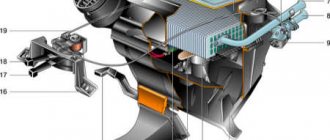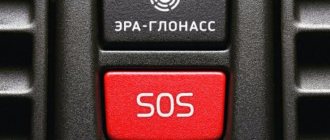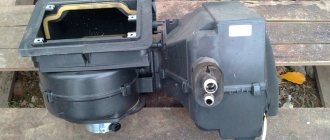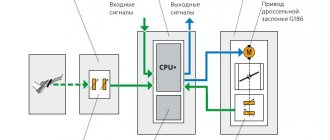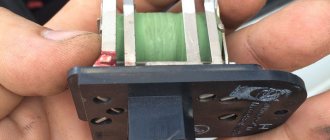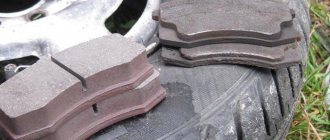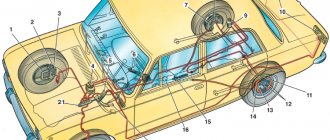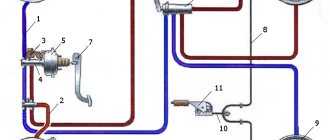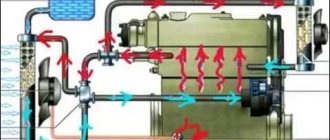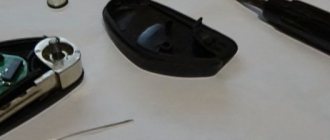ABS system (ABS) is an anti-lock braking system. An extremely useful option that prevents the car’s wheels from locking during emergency braking. Almost all car owners know this statement, but we will tell you how this system works, how to behave when it is triggered in different situations, and how to identify problems with ABS in our review article.
Modern cars are equipped with a variety of systems and sensors. Some increase comfort, others improve environmental performance and much more. But the passive and active safety systems are especially useful. The ABS system is an active safety element, meaning it functions and provides its benefits even before an accident occurs.
For reference: passive safety systems include seat belts, airbags, safety glass, door crossbars and much more. All these elements play one role or another directly at the moment of a collision in an accident.
An anti-lock braking system is installed on most cars as an additional option. There are models with standard ABS, that is, it is available on all trim levels. One of these models is the Lada Vesta; in its simplest configuration it already has ABS+BAS (Anti-lock braking system with emergency brake assist).
Anti-lock braking system (ABS). Description
A car's Anti-lock Braking System is a system that regulates the brake fluid pressure in the brake circuits, which helps prevent the wheels from locking during braking. In other words, this system prevents skidding, which provides the following benefits:
- Increasing vehicle stability.
- Reducing braking distance.
- Saving rubber and preserving the studs on car tires.
In addition to its primary function, anti-lock braking system sensors and valves are used for many other vehicle systems. For example, exchange rate stability system or emergency braking assistance system. The stability control system brakes certain wheels during sharp turns or drifts, which significantly improves safety performance. Brake Assist keeps the brake pedal depressed until the vehicle comes to a complete stop.
Working principle of ABS
ABS prevents the wheels from locking during sudden braking, and as a result prevents the car from skidding. When the system functions correctly, the vehicle brakes effectively and remains fully controllable. Why is it so important to prevent even one wheel from locking when braking? When sliding, the coefficient of friction is significantly lower than when at rest. When a wheel is locked, it slides along the road surface - friction decreases and braking is ineffective.
When the surface of the tire and the road are at rest, relative to each other, the coefficient of friction is as high as possible and braking occurs effectively.
An experienced driver himself can feel the moment the wheels lock and lighten the pressure on the brake pedal a little. In this case, the wheels begin to rotate again and the grip on the road surface becomes better. But the car's braking system does not allow you to control the braking force on each wheel.
A modern ABS system controls the rotation of each wheel and is capable of increasing or decreasing the braking force on each wheel separately from the others. As soon as one wheel locks, the system reduces the brake pressure on that wheel, allows it to start spinning, and then increases the braking force again to improve braking. And this happens with each wheel - effective intermittent braking is achieved, which maintains vehicle controllability.
How the anti-lock braking system works
How to diagnose ABS yourself? — to answer this question with confidence, it is important to know the structure of the system itself. To do this, let’s look at several individual parts of it:
- Speed sensors. Sensors are located near each wheel of the car. They transmit information about the rotation speed of each wheel to the ABS control unit.
- ABS control unit. The control unit receives signals from speed sensors, analyzes the situation, and, in the event of a wheel lock, transmits a command to the hydraulic control unit.
- The hydraulic control unit, having received a signal about a blocked wheel, closes the brake fluid channel going to this wheel.
The result is that as soon as the wheel is locked, the system “releases” it. Once this happens, it is blocked again. All this happens with high frequency, and as a result, the wheels rotate at maximum effort, but without switching to skidding.
When should you contact a technical center to diagnose the brake system?
So. In your car, an icon or warning light is lit on the instrument panel warning of a problem with the anti-lock braking system. In this case, first of all, you need to make sure that the indicator light indicates a problem with the ABS, and not a malfunction of the entire brake system. To check this, listen carefully to your car when braking and pay attention to the brake pedal.
If, when braking, you hear extraneous noises (creaks, knocks, whistles, etc.) or the brake pedal has become too soft (softer than usual), then your direct route to a technical center, where specialists will conduct a thorough diagnosis of the entire brake system. Remember that these symptoms indicate a serious breakdown of the entire braking system, which can lead to a driving accident. Therefore, if the brakes in your car become bad, it is not recommended to continue driving the car, as this is very dangerous. In this case, it is better to call a tow truck.
DIY ABS diagnostics
The very first sign of a malfunctioning ABS system is a light on the dashboard. After it lights up, it is important to immediately make a diagnosis. Let's consider the actions that need to be taken if the ABS malfunctions:
- Check the fuses and relays of the anti-lock braking system control unit.
- Compare the tire pressure - it should be the same everywhere.
- Examine the rotor of each sensor for contamination.
- Use a tester to measure the resistance in each of the sensors with the ignition on. Lift the wheel on a jack and rotate it and observe the changes.
- Check the integrity of the wires coming from the sensors to the control unit.
- Check the integrity of the wires going to the ABS hydraulic unit.
The best diagnostic option would be to check by connecting a laptop or smartphone to the diagnostic connector - this will save a lot of time and instantly determine the cause of the breakdown.
Tools, accessories and consumables
To diagnose the system without the use of expensive equipment, you will need a service manual for your car (a book on the operation and repair of your vehicle model), a regular set of automotive tools that can be bought at any auto store, as well as a high-impedance multimeter (with high resistance). If you can’t find a service repair manual for your car model on sale, look for it on the Internet and download it to your computer or smartphone.
ABS Lada Vesta error codes and their interpretation
Diagnosing ABS yourself is a rather difficult task if you do not have diagnostic equipment (cable, laptop, and software). If you have the ability to read errors, then by comparing their codes with the description, you can much faster determine the cause of the malfunction. The following are the errors that “light up” the anti-lock braking system malfunction light:
Thanks for subscribing!
- U0121 - no data from the ABS system controller
- U0122 - no data from ESP system controller
- U0415 - incorrect data from the ABS system controller
- U0416 - Invalid data from the ESP system controller
In most cases, the absence of data from the controller indicates a malfunction. If the diagnostics indicate errors U0415 or U0416, then there is a high probability of sensor malfunction or damaged wires. Also, do not forget that with different tire pressures, the control system may receive incorrect data from the controller and indicate the last two errors.
Sensors and vehicle weight
Particular attention should be paid to sensors. Check the touch sensors for any mechanical damage.
To understand whether the sensors provide accurate information, it is necessary to check the wheel bearing for the absence of play, as well as the performance of the brakes, the integrity of the pads, the tightness of the turbocharger, and so on.
All necessary tests must be carried out on special stands. This is the only way to count on the most accurate inspection and measurement results.
You should definitely make sure that the vehicle's ground has normal contact.
Also read - Signs of a malfunction of the mass air flow sensor, checking the mass air flow sensor for functionality, diagnostics with a multimeter, tester, DIY replacement.
Anti-lock braking system and safety
Many people mistakenly believe that ABS does not bring any benefit and is even an obstacle to safe driving. This is a rather deep-rooted opinion, and to the question “how do you justify this?” very often you can hear something like “on loose snow, ABS increases braking distance.” In fact, the length of the braking distance is not particularly different. But the main goal of this system is not to shorten the braking distance, but to increase traction during braking. It is impossible to skid and at the same time go around an obstacle - the wheels will not obey you. But if your car is equipped with an ABS system, then you don’t have to worry - feel free to press the brake pedal all the way and continue to maneuver.
It is important to understand that your mind adapts to this system, and it is very difficult to get used to the ABS not working. It is for this reason that it is necessary to immediately diagnose and repair the anti-lock braking system at the first sign of a malfunction.
Is it possible to drive a car with the ABS icon on?
It is worth noting that despite the breakdown of the ABS system and the appearance of a lit indicator on the instrument panel, the mechanical braking system in your car, as a rule, continues to function, so in principle you can continue driving, but without an electronic system that prevents the wheels from locking when braking. That is, if the ABS system fails, you can safely operate the car.
However, in this case you need to be extremely careful when braking on a wet, snowy or slippery road, since the wheels of your car without an ABS system may lock. Therefore, in the event of an ABS malfunction, it is not recommended to operate the car for a long period without appropriate repairs; on the contrary, it is advisable to diagnose the cause of the error as quickly as possible and eliminate it.
How to get to sensors and wires
To check the condition of the ABS system sensors and wires, you first need to remove the wheels. For example, one by one, lifting the car with a jack from the required side. This way you will have access to wires and sensors. If, while inspecting the sensors and wiring harness of the anti-lock brake system, you find damage or notice that the sensor is not securely fastened enough and is loose, consider that the cause of the error on the instrument panel indicating an ABS malfunction has been found.
If during the inspection you do not find any external damage, remove the speed sensors from the hub (or axle) and check their resistance using a multimeter (if you have not done this before). Control readings of resistance in speed sensors can be found in a special book on the operation and repair of your car model.
It is worth noting that all car owners are recommended to systematically inspect the wires of the wheel rotation sensors, even if the ABS is functioning properly and the ABS indicator does not light up on the instrument panel. The bottom line is that since the speed sensors and wires are located at the bottom of the vehicle, they are constantly exposed to the aggressive influence of the external environment. The main enemy of wheel speed sensors and wires is snow, water and salt, which is contained in the road reagent.
Contact corrosion, why corrosion can cause an ABS error
Also, when inspecting the wiring harness connector contacts, you need to pay attention to the corrosion of these contacts. Remember, even minor corrosion and oxidation chemicals can increase resistance in the ABS system circuit. Since a low voltage of electricity (millivolts) is transmitted through the wires, even a minimal increase in resistance as a result of contamination of the connector contacts can lead to incorrect operation of the entire ABS electrical system, in particular, and provoke an error leading to the ABS indicator lighting up on the instrument panel.
How to check wheel speed sensors
If the anti-lock braking system controller is intact and working, and disconnecting the wiring harness connector from the ABS did not help solve the problem of the ABS indicator light on the instrument panel, then it’s time to check the serviceability of the wheel speed sensors that transmit data to the ABS control unit. First of all, you need to measure the resistance of the sensors, comparing them with the control values indicated in the operating manual for your machine.
If the resistance is within acceptable limits, it is necessary to visually inspect the wheel speed sensors, as well as the wires suitable for them, and the gears installed on each wheel. It is worth noting that many modern cars currently use sensors that require electrical power. ABS sensors with a Hall effect are often used (a semiconductor wafer is mounted inside the sensor), which, interacting with a magnetic ring located on the wheel hub, are capable of recording changes in the magnetic field and the rate of electron formation on the wafer in the ABS sensor.
Unfortunately, not all cars have ABS sensors and their wires that are reliably protected from the effects of an aggressive external environment. As a result, ABS sensors and wires can fail due to damage or dirt.
Is it risky to continue driving if the ABS system is faulty?
People think differently, but if you think about it, there is nothing terrible here. After all, if ABS turns off, simple brakes will work as they should. The only thing that can be annoying is the ABS error indicator constantly burning in front of your eyes.
How to eliminate an ABS error yourself
Typically, an error can appear if the sensor itself is dirty. To fix the problem you need to clean it. But first you need to find out which wheel the sensor broke down on. This is found out by using a scanner on the car. You can do this yourself using a mobile phone together with an error scanner.
Having found out which of the 4 sensors is broken, you need to remove the wheel and find out where the sensor is connected. Then you need to dismantle it and clean it from contamination. Most likely he got stuck. This is usually why the malfunction error message comes on.
You shouldn’t immediately go and order new sensors; you need to start with smaller ones and find out the reason. If there is no money or opportunity to repair the vehicle, then there is no need to be upset, because before we drove without ABS and everything was fine.
28.04.2019
